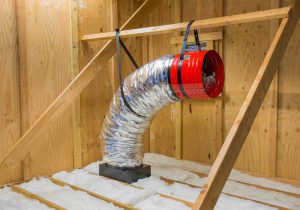A whole-house fan is an effective means of cooling a house, and is far less expensive to run than an air conditioner.
Whole house fan definition: Large fan (48″ in diameter) which pulls air through the house via open windows. This has large louvers (48″ x 48″) in the ceiling of a hallway on the upper floor. Operated with a switch. These can’t be used when you are using air conditioning.
A whole-house fan is an effective means of cooling a house, and is far less expensive to run than an air conditioner. Whole-house fans can reduce indoor temperatures by 3 to 8 degrees F, depending on the outside temperature.
Through prudent use of a whole-house fan, you can cut air conditioner use by 15 to 55 percent.
If a well-insulated house is closed up during the heat of the day, it will heat up inside slowly like an insulated ice cube. In the evening when it’s cooler outside than inside, and you open the windows, a whole-house fan blows the hot air out of the house.
The fan should be centrally located so that it draws air from all rooms in the house. Be sure your attic has sufficient ventilation to get rid of the hot air.
To ensure a safe installation the fan must have an automatic shutoff in case of fire.
Ceiling, paddle, and portable fans produce air motion across your skin that increases evaporative cooling.
A moderate breeze of one or two miles an hour can extend your comfort range by several degrees and will save energy by allowing you to set your air conditioner’s thermostat higher or eliminate the need for air-conditioning altogether.
Less frequent use of air conditioning by setting the thermostat higher will greatly cut cooling bills.



 Click To Call / Text
Click To Call / Text